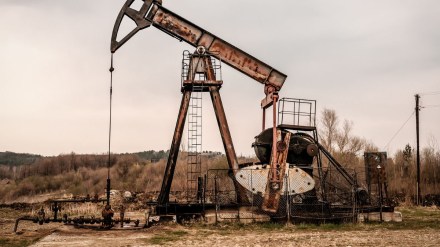Since the conflict between Israel and Iran began two weeks ago, the price of crude oil has jumped by 13.7%. Supplies from Iran, a major oil producer, may be severely disrupted. Depending on how the conflict evolves, oil prices could rise much further.
A good indicator here is oil volatility. The OVX index (akin to the VIX index for stocks) has nearly doubled in the last two weeks. This means any market move is expected to be twice as large as normal.
How would rising oil prices affect the Indian economy?
India imports close to 90% of its crude oil, meaning it is vulnerable to high oil prices. But are oil prices really that high? Even with the recent increase, oil prices remain low by historical standards. Here’s a chart of the dollar price of oil over the last 25 years.
Crude oil prices peaked in 2008, when prices reached $147 per barrel. In those days, forecasters were predicting $200 oil that never materialized. At the current level near $70, prices are less than half their peak.
But this chart understates how low prices are today. Here’s another chart, this one is the rupee real price of oil. This means that it is adjusted for inflation. The adjustment goes backwards, meaning that previous prices are adjusted higher to account for inflation.
In real terms, the price of oil today is 66% lower than its peak in 2008. Even if oil prices were to rise further, there’s a long way to go before we are anywhere near 2008 levels.
In 2008, the GDP growth rate dipped to 3.1%, compared to typical levels between 7% and 8%. While oil prices were not the only factor causing the dip, it likely was a major reason. The last time oil prices were high in 2011-12, GDP growth dipped to 5.2%, again from the typical levels between 7% and 8%.
In recent years, oil prices have been lower, and GDP growth has been strong. Other than during the COVID-19 pandemic, GDP growth has consistently been above 7%.
High oil prices are also responsible for inflation. Between 2008 and 2012, the average annual inflation rate was 9.9%. Since then, the average annual inflation rate is 5.5%. Clearly, oil prices effect inflation, as costs get passed on to consumers.
But oil prices today are nowhere near as high as they once were. Which means that the economy is unlikely to be negatively affected by recent geopolitical events. Oil prices would have to get a lot higher before prices have a material effect.
Why are oil prices so much lower today?
The main reason is increased U.S. oil production. Since 2012, US oil production has approximately doubled. The shale revolution turned the U.S. into the world’s largest oil producer.
Supply disruptions from the Middle East today won’t have the same effect on prices as they would have had in the past. And this is good news for the economy.
Note: The purpose of this article is to share interesting charts, data points and thought-provoking opinions. It is NOT a recommendation. If you wish to consider an investment, you are strongly encouraged to consult your advisor. This article is for strictly educative purposes only.
Asad Dossani is an assistant professor of finance at Colorado State University. His research covers derivatives, forecasting, monetary policy, currencies, and commodities. He has a PhD in Economics. He has previously worked as a research analyst at Equitymaster, and as a financial analyst at Deutsche Bank.
Disclosure: The writer invests in commodity markets.
